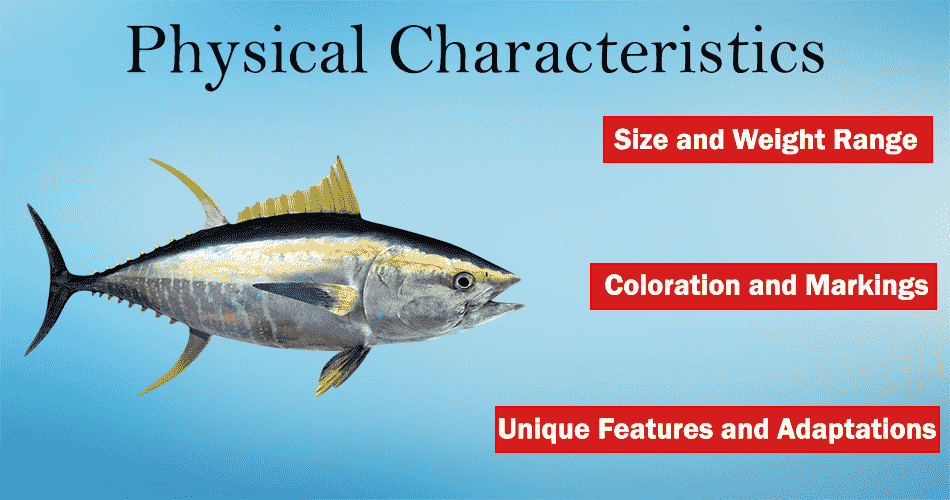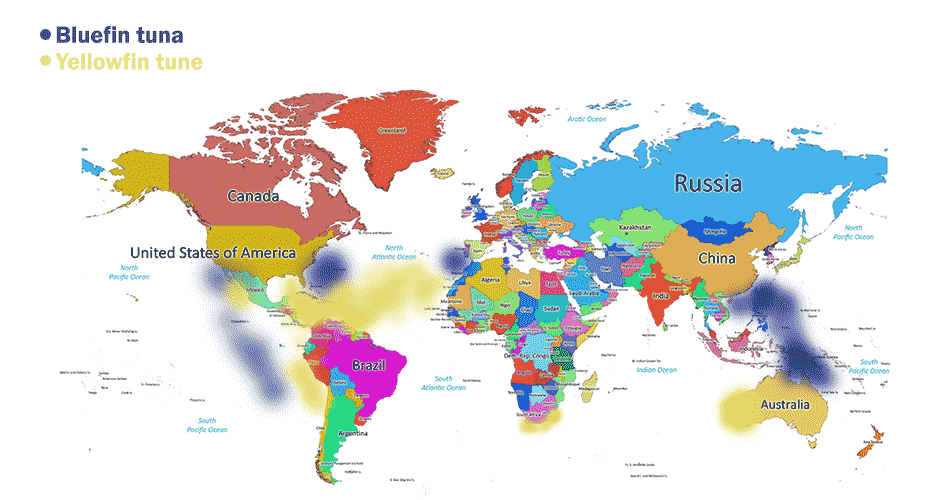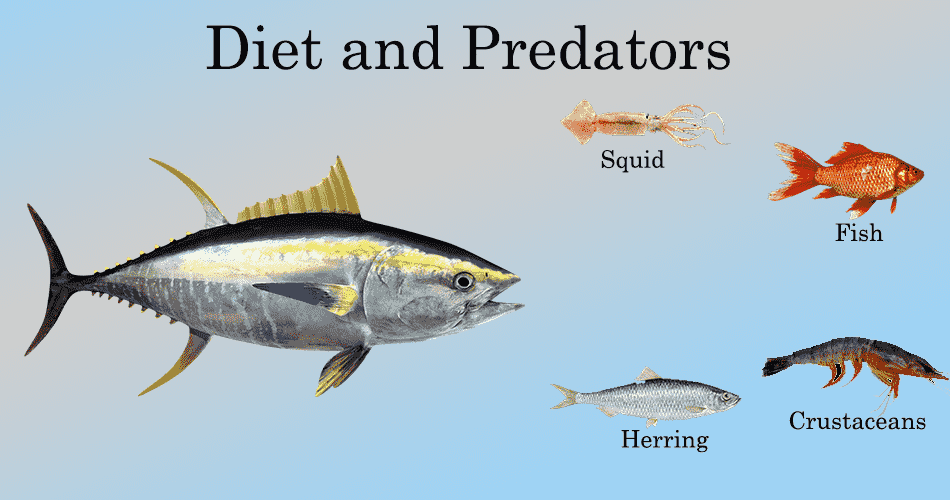
Yellowfin tuna (Thunnus albacares) is a highly sought-after species in both commercial and recreational fishing. This large and powerful fish is renowned for its speed, strength, and delicious flesh, making it a prized catch worldwide. Yellowfin tuna is a member of the mackerel family and is characterized by its sleek body, vibrant yellow fins, and metallic blue-black coloration on its back.
With its significant commercial value and popularity among anglers, understanding the facts and information about yellowfin tuna is crucial for sustainable management and conservation efforts. In this article, we will delve into the fascinating world of yellowfin tuna, exploring its physical characteristics, habitat, life cycle, culinary uses, and conservation status.
Physical Characteristics

Yellowfin tuna exhibits a range of physical characteristics that contribute to its unique identity in the marine world.
A. Size and Weight Range:
Yellowfin tuna is known for its impressive size, with adult specimens typically reaching lengths between 4 and 7 feet (1.2 to 2.1 meters) and weighing anywhere from 80 to 400 pounds (36 to 181 kilograms). However, exceptional individuals have been recorded exceeding 8 feet (2.4 meters) and weighing over 400 pounds (181 kilograms).
B. Coloration and Markings:
The name “yellowfin” derives from the vibrant yellow coloring found on the fins and tail of this species. The body of a yellowfin tuna is generally metallic blue-black on the upper portion, fading into a silver-white belly. A distinct golden stripe, often referred to as a “finlet,” runs along the side of the fish, accentuating its striking appearance.
C. Unique Features and Adaptations:
Yellowfin tuna possess several adaptations that contribute to their exceptional swimming capabilities. Their streamlined bodies and crescent-shaped tails enable them to reach impressive speeds, often exceeding 50 miles per hour (80 kilometers per hour). Additionally, yellowfin tuna have a heat exchange system called the rete mirabile, which helps maintain their body temperature higher than the surrounding water, providing an advantage in colder depths. This adaptation supports their ability to thrive in a wide range of oceanic environments.
Habitat and Distribution

Yellowfin tuna are widely distributed throughout the world’s oceans, inhabiting both tropical and subtropical waters. Their distribution is influenced by various factors, including water temperature, food availability, and spawning requirements.
A. Global Distribution and Major Fishing Grounds:
Yellowfin tuna can be found in all major oceans, including the Atlantic, Pacific, and Indian Oceans. They are particularly abundant in areas such as the Western and Central Pacific, Eastern Pacific, Gulf of Mexico, and the Indian Ocean. These regions are renowned as major fishing grounds for yellowfin tuna due to their high population densities.
B. Preferred Water Temperatures and Depths:
Yellowfin tuna prefer water temperatures ranging from 68 to 88 degrees Fahrenheit (20 to 31 degrees Celsius). They are known to inhabit both the surface waters and deeper depths, commonly found at depths of 300 to 1,000 feet (90 to 300 meters). However, they can also venture into shallower coastal areas and even swim near the surface.
C. Migration Patterns and Behavior:
Yellowfin tuna are highly migratory fish, undertaking extensive journeys in search of suitable feeding grounds and spawning areas. They exhibit both horizontal and vertical migrations, moving across vast distances in response to changes in water temperature and the availability of prey. Yellowfin tuna often form schools with other tuna species, such as skipjack and bigeye tuna, further influencing their migration patterns.
Diet and Predators

Yellowfin tuna have a diverse diet and are formidable predators in the marine ecosystem. Their feeding habits and interactions with prey and predators play a crucial role in their survival and ecological balance.
A. Typical Prey Species:
Yellowfin tuna are opportunistic feeders, consuming a wide range of prey species. Their diet primarily consists of small fish, including anchovies, sardines, herring, and mackerel. They also feed on cephalopods like squid and octopus, as well as various crustaceans such as shrimp and crabs.
B. Hunting Techniques and Feeding Habits:
Yellowfin tuna employ various hunting techniques to capture their prey. They are known for their speed and agility, often chasing down their targets at high speeds. Yellowfin tuna are capable of rapid bursts of acceleration, allowing them to surprise and engulf their prey in a swift strike. They also utilize their keen eyesight to detect and locate schools of fish or other prey items.
C. Natural Predators and Threats:
While yellowfin tuna are formidable hunters, they face predation from larger marine predators. Sharks, including great white sharks and tiger sharks, are known to prey on yellowfin tuna, particularly when they are smaller or injured. Other potential threats include marine mammals such as dolphins and killer whales, which can target yellowfin tuna as part of their diet.
In addition to natural predators, yellowfin tuna also face human-induced threats. Overfishing and excessive commercial harvesting pose significant challenges to their populations. Bycatch, the unintended capture of yellowfin tuna in fishing nets or lines targeting other species, is also a concern. Conservation efforts and sustainable fishing practices are vital to mitigate these threats and ensure the long-term survival of yellowfin tuna populations.
Life Cycle and Reproduction

Understanding the life cycle and reproductive characteristics of yellowfin tuna is essential for managing and conserving their populations. Let’s explore their breeding behaviour, growth rates, reproductive strategies, and fecundity.
A. Breeding Behavior and Spawning Grounds:
Yellowfin tuna are pelagic spawners, meaning they release their eggs and sperm into the open water column. They typically form large aggregations during spawning, where multiple individuals come together to reproduce. Spawning grounds are often found in warm tropical waters, near oceanic islands, or offshore banks, where currents are favourable for egg and larval survival.
B. Growth Rates and Age at Maturity:
Yellowfin tuna exhibit relatively rapid growth rates compared to other tuna species. Juvenile yellowfin tuna can grow at an average rate of around 2 inches (5 centimetres) per month during their early stages. The age at maturity varies among populations, but it is generally reached between 2 and 5 years old. Factors such as food availability and environmental conditions can influence the growth rates and age at maturity of yellowfin tuna.
C. Reproductive Strategies and Fecundity:
Female yellowfin tuna are capable of producing a large number of eggs during each reproductive cycle. Their fecundity (number of eggs produced) can range from several hundred thousand to several million eggs, depending on the size and condition of the individual. Fertilized eggs hatch into larvae, which eventually develop into juveniles and start their journey in the marine environment.
Commercial and Recreational Importance
Yellowfin tuna holds significant economic and recreational value, making it a prized species in both commercial fisheries and recreational angling pursuits.
A. Economic Significance and Commercial Fisheries:
Yellowfin tuna is highly valued in the global seafood market due to its flavourful and versatile meat, which is sought after for sashimi, sushi, and various other culinary preparations. Commercial fisheries target yellowfin tuna extensively, with large-scale operations utilizing various fishing methods such as longlining, purse seining, and pole-and-line fishing. The economic impact of yellowfin tuna fishing is substantial, providing employment opportunities and contributing to local economies in many coastal regions.
B. Popular Fishing Methods and Techniques:
Yellowfin tuna is a prized catch among recreational anglers due to its powerful fighting abilities and culinary appeal. Anglers employ various fishing methods and techniques to target yellowfin tuna, including trolling, chunking, and live bait fishing. These methods often involve the use of specialized equipment, such as heavy-duty fishing rods and reels, and offshore fishing vessels capable of venturing into deeper waters where yellowfin tuna are commonly found.
C. Conservation Efforts and Sustainable Fishing Practices:
As yellowfin tuna populations face increasing pressure from fishing activities, conservation efforts are crucial to ensure their long-term sustainability. Many organizations and governing bodies have implemented regulations and practices to promote sustainable fishing, including catch limits, size restrictions, and the protection of spawning areas. Additionally, initiatives like the certification and promotion of pole-and-line fishing, which has lower levels of bycatch and reduced environmental impact, contribute to the conservation of yellowfin tuna populations.
Culinary Uses and Nutritional Value
Yellowfin tuna is highly regarded for its culinary attributes, and its nutritional composition provides several health benefits.
A. Culinary Preferences and Cultural Significance:
Yellowfin tuna is a prized ingredient in many cuisines around the world. Its firm, flavourful flesh makes it well-suited for various preparations, including sushi, sashimi, grilling, searing, and baking. It is a staple in Japanese cuisine, where it is known as “maguro.” In Mediterranean and Latin American cuisines, yellowfin tuna is often used in ceviche and grilled fish dishes. The cultural significance of yellowfin tuna can vary across regions, but it is commonly associated with celebratory occasions, traditional recipes, and coastal communities.
B. Nutritional Composition and Health Benefits:
Yellowfin tuna is a nutrient-dense food with several health benefits. It is a rich source of high-quality protein, essential amino acids, and omega-3 fatty acids, which promote heart health and reduce inflammation. Yellowfin tuna also provides essential minerals like selenium, magnesium, and potassium. Its low saturated fat content and high levels of vitamins B6 and B12 make it a nutritious choice for maintaining a balanced diet.
C. Cooking Methods and Recipe Ideas:
Yellowfin tuna’s versatility allows for a variety of cooking methods. It can be enjoyed raw in sushi and sashimi, seared briefly to maintain a rare or medium-rare center, or cooked through by grilling, baking, or pan-frying. Yellowfin tuna pairs well with various seasonings and marinades, including soy sauce, ginger, garlic, and citrus flavors. It can be incorporated into salads, tacos, and sandwiches, or served as a main course with vegetable sides.
Some popular recipe ideas include yellowfin tuna poke bowls, grilled yellowfin tuna steaks with a citrus glaze, or yellowfin tuna ceviche with fresh herbs and lime juice.
The Bottom Line
Yellowfin tuna is a remarkable species with its distinctive physical characteristics, wide distribution, and vital role in commercial and recreational fishing. Understanding its habitat preferences, life cycle, and reproductive strategies is crucial for effective conservation and sustainable fishing practices. Yellowfin tuna’s economic significance, culinary versatility, and nutritional value make it a highly valued seafood resource globally.
However, it is important to balance the demand for yellowfin tuna with responsible fishing methods and conservation efforts to ensure its long-term survival. By promoting sustainable practices and maintaining healthy populations, we can continue to enjoy the culinary delights of yellowfin tuna while preserving this magnificent species for future generations.